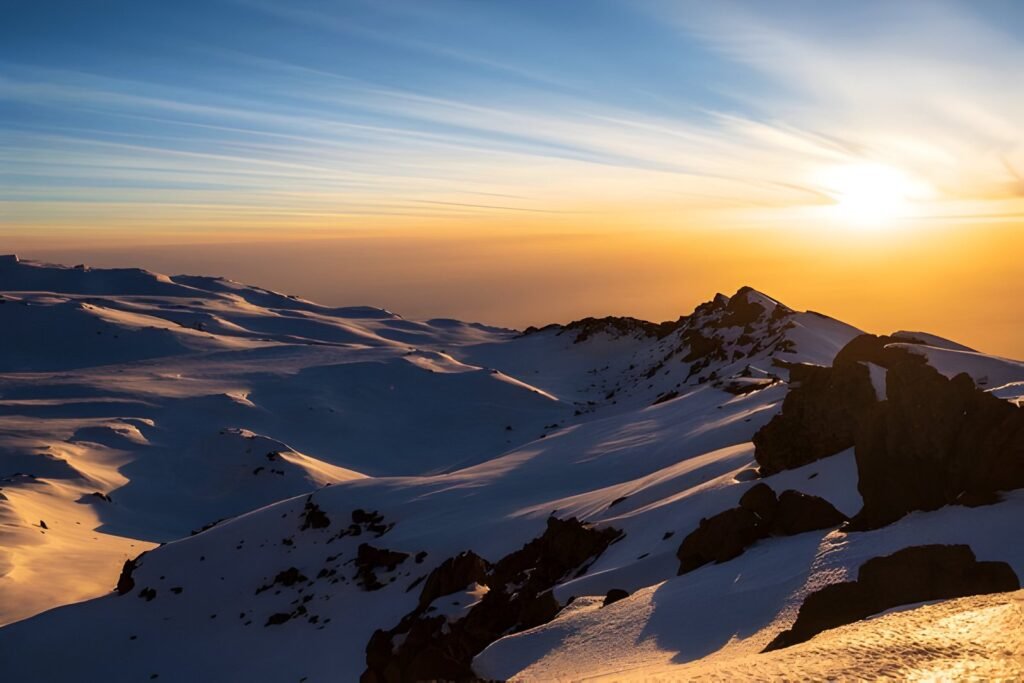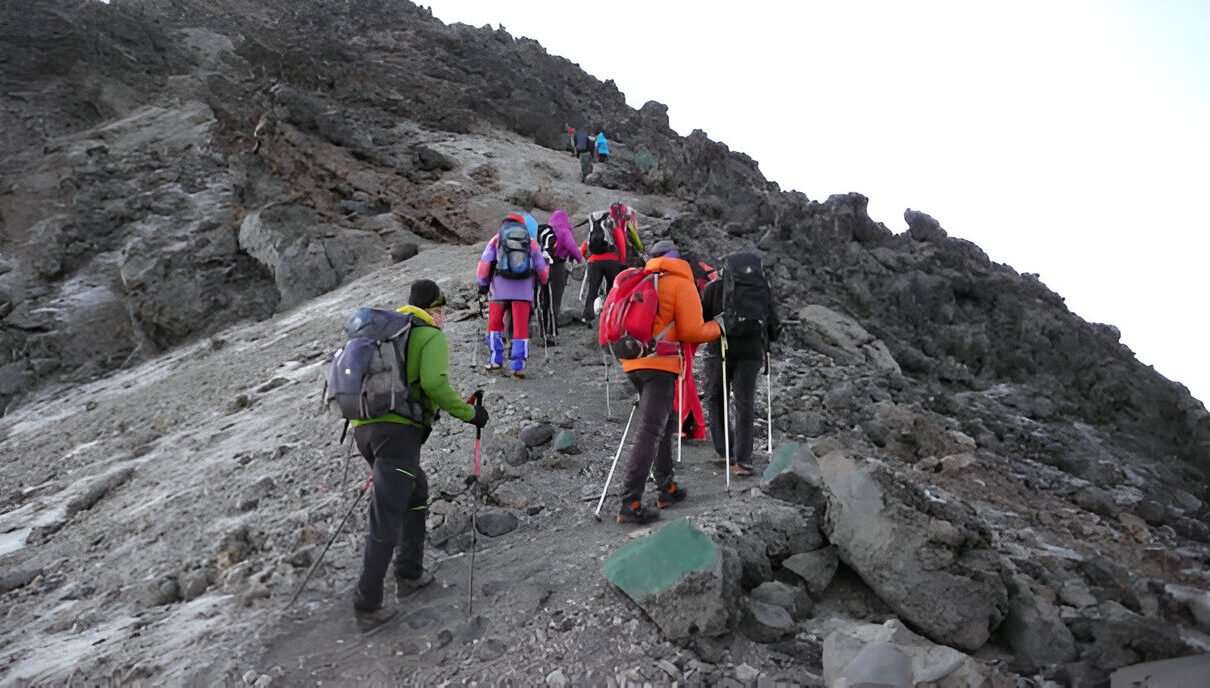8-Day Lemosho Kilimanjaro Group Join Trek 2025/2026 If you’re planning to climb Mount Kilimanjaro, the 8 Days Lemosho Route Kilimanjaro Group Join package for 2025/2026 is an ideal choice. Known for its stunning scenery, gradual ascent, and high summit success rates, the Lemosho Route provides climbers with a beautiful journey to the roof of Africa. Whether you’re a beginner or an experienced trekker, joining a group on the Lemosho Route offers a perfect combination of adventure, camaraderie, and expert guidance.
The 8-Day Lemosho Kilimanjaro Group Join Trek 2025/2026 is one of Kilimanjaro’s longer paths, allowing ample time for acclimatization and increasing your chances of reaching Uhuru Peak successfully. For detailed guidance on preparing for this trek, visit Kilimanjaro Climb Specialist to explore the best tips and information to ensure your climb is smooth and enjoyable.

Why Choose the 8-Day Lemosho Kilimanjaro Group Join Trek 2025/2026 ?
The 8-Day Lemosho Kilimanjaro Group Join Trek 2025/2026 is popular for several reasons. It offers spectacular views, a quieter trail, and a longer acclimatization period. These factors contribute to the high success rates for reaching the summit.
Scenic Views and Less Crowds
Unlike some other routes, the Lemosho Route starts from the west side of Kilimanjaro, passing through beautiful rainforests and scenic valleys. The route is known for its panoramic views of the Shira Plateau, Mount Meru, and the western breach. Additionally, since it’s less crowded, you can enjoy a more peaceful and immersive trekking experience.
- Learn more about the diverse landscapes of Kilimanjaro at Tanzania National Parks.
Better Acclimatization and Success Rates
The gradual ascent of the Lemosho Route allows trekkers to adjust to the altitude more easily. This extra time for acclimatization plays a major role in the route’s higher success rates compared to shorter, more direct routes.
- Discover how acclimatization impacts Kilimanjaro climbs at Altitude.org.

Group Joining Benefits
Joining a group for the 8-day Lemosho Route offers several benefits. Not only do you get to share the experience with like-minded adventurers, but you also reduce the overall cost. Climbing as part of a group also provides moral support, making the challenge easier and more enjoyable.
For more details on joining a group climb, visit Eddy Tours & Safaris
8-Day Lemosho Kilimanjaro Group Join Trek 2025/2026 Itinerary
The 8 Days Lemosho Route Kilimanjaro Group Join itinerary offers a well-paced trek, allowing ample time to acclimatize and enjoy the scenery. Here’s a day-by-day breakdown:
Day 1: Londorossi Gate to Mti Mkubwa (Big Tree Camp)
- Elevation: 2,100m to 2,650m
- Distance: 6km
- Time: 3-4 hours
Your trek starts at the Londorossi Gate, where you’ll pass through lush rainforest. Expect to see wildlife such as monkeys and birds as you make your way to Big Tree Camp
Day 2: Mti Mkubwa to Shira 1 Camp
- Elevation: 2,650m to 3,610m
- Distance: 8km
- Time: 5-6 hours
This day takes you through the moorland and onto the Shira Plateau. The gradual ascent offers fantastic views of the surrounding landscapes.
Day 3: Shira 1 to Shira 2 Camp
- Elevation: 3,610m to 3,850m
- Distance: 7km
- Time: 3-4 hours
A shorter day of trekking across the Shira Plateau. You will enjoy the vast open plains and incredible views of Kilimanjaro’s snow-capped peak.
Day 4: Shira 2 to Barranco Camp (via Lava Tower)
- Elevation: 3,850m to 4,640m (Lava Tower), descend to 3,960m
- Distance: 10km
- Time: 7-8 hours
This day is important for acclimatization. You will trek up to Lava Tower and then descend to Barranco Camp, which allows your body to adjust to the altitude. - For detailed tips on acclimatization, visit Altitude Medicine.
Day 5: Barranco Camp to Karanga Camp
- Elevation: 3,960m to 4,035m
- Distance: 5km
- Time: 4-5 hours
Today, you will climb the famous Barranco Wall, a steep and challenging part of the trek, followed by a more gradual trek to Karanga Camp.
Day 6: Karanga Camp to Barafu Camp
- Elevation: 4,035m to 4,640m
- Distance: 4km
- Time: 3-4 hours
You’ll make your way to Barafu Camp, where you will rest and prepare for your summit attempt. The camp offers stunning views of the peak and surrounding landscapes.
Day 7: Barafu Camp to Uhuru Peak, Descend to Mweka Camp
- Elevation: 4,640m to 5,895m (Uhuru Peak), descend to 3,080m
- Distance: 17km
- Time: 12-15 hours
Summit day begins at midnight. You will push towards the summit, reaching Uhuru Peak by sunrise. After celebrating your achievement, you’ll begin your descent to Mweka Camp. - For summit success stories, visit Mountain IQ.
Day 8: Mweka Camp to Mweka Gate
- Elevation: 3,080m to 1,640m
- Distance: 10km
- Time: 3-4 hours
On the final day, you’ll trek through the rainforest back to Mweka Gate, where you’ll receive your summit certificates.
What to Pack for the 8-Day Lemosho Kilimanjaro Group Join Trek 2025/2026
Packing the right gear is essential for a successful trek. Here are some important items to bring on the 8-Day Lemosho Kilimanjaro Group Join Trek 2025/2026:
1. Warm Clothing
Temperatures can drop significantly at night, especially at higher altitudes. Be sure to pack warm layers, including thermal underwear, fleece jackets, and a down jacket.
- For packing tips, visit REI’s Kilimanjaro Packing List.
2. Trekking Poles
Trekking poles are highly recommended for steep sections like the Barranco Wall and for reducing strain on your knees during the descent.
- Learn more about the benefits of trekking poles at Trekking Poles Guide.
3. Sleeping Bag
Bring a sleeping bag rated for sub-freezing temperatures, as the nights can get very cold, especially near the summit.
- Check out sleeping bag options at Mountain Hardwear.
4. High-Calorie Snacks
Bring energy-dense snacks such as nuts, dried fruits, and energy bars to keep your energy levels up during long trekking days.
- For nutrition tips during high-altitude trekking, visit Climbing Nutrition.
How to Prepare for the 8-Day Lemosho Kilimanjaro Group Join Trek 2025/2026
1. Train for Endurance
While the 8-Day Lemosho Kilimanjaro Group Join Trek 2025/2026 allows for acclimatization, it’s still important to prepare physically. Regular cardio exercises such as running, cycling, or hiking will help you build the stamina needed for the trek.
- For training tips, visit Trek Tips.
2. Learn About Altitude Sickness
Understanding the symptoms of altitude sickness and how to prevent it can help you manage the higher altitudes on Kilimanjaro. Take it slow and drink plenty of water to reduce the risk.
- Discover more about altitude sickness at Altitude.org.
3. Stay Hydrated
Drinking plenty of water is crucial at high altitudes. You should aim to drink at least 3-4 liters of water a day while trekking.
- For hydration tips, visit Hydration Guide.
FAQs: 8-Day Lemosho Kilimanjaro Group Join Trek 2025/2026
1. Is the Lemosho Route suitable for beginners?
Yes, the Lemosho Route is suitable for beginners due to its gradual ascent and longer acclimatization period, which increases the chance of success.
2. How much does the 8-Day Lemosho Route cost?
Costs for the 8-Day Lemosho Route vary depending on the tour operator but generally range from $2,500 to $4,000.
- For more pricing details, visit Climb Kilimanjaro Guide.
3. What is the success rate for the Lemosho Route?
The success rate for the Lemosho Route is high, typically around 90%, due to the longer duration and better acclimatization opportunities.
4. What is the best time to climb Kilimanjaro via the Lemosho Route?
The best time to climb Kilimanjaro is during the dry seasons, from January to March and from June to October.
- For weather updates, visit Tanzania Meteorological Agency.
Ready to join the 8-Day Lemosho Kilimanjaro Group Join Trek 2025/2026 ? Start planning your adventure with Kilimanjaro Climb Specialist or Eddy Tours & Safaris for expert guidance and group booking details.

